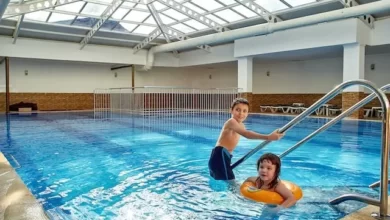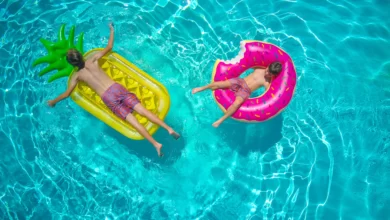Dive In: 13 Questions on Swimming Activities for All Ages – A Comprehensive Guide

Welcome to the watery world! In this article, we will dive into a spectrum of swimming activities tailored to different age groups. Whether you are a parent, teacher, or enthusiast seeking a refreshing way to enjoy the water, this guide has you covered. Let’s navigate the exciting world of swimming activities by providing in-depth answers to your questions and detailed explanations to make your aquatic experiences safe, enjoyable, and unforgettable.
Table of Contents
Why is swimming an excellent activity for people of all ages?
Swimming is a truly universal activity, offering a multitude of benefits regardless of age. It’s a low-impact exercise that engages various muscle groups, enhances cardiovascular health, and gives an exact way to beat the heat. Moreover, swimming is a life-saving skill that can be enjoyed at every stage of life.

What swimming activities are suitable for infants and toddlers?
For the youngest swimmers, it is important to create a gentle introduction to the water. water acclimatization can be achieved through activities like water play, floating and short, supervised dips. Singing songs and playing with water-safe toys can make their early encounters with water enjoyable and comfortable.
What are some swimming activities for young children (ages 3-6)?
At this age. Children can transition into basic swimming lessons. Activities such as water confidence exercises, learning to float, and practising bubble blowing can be introduced. Games that involve retrieving objects from the pool floor, like dive sticks, enhance their swimming skills.
What are appropriate swimming activities for older children and pre-teens (ages 7–12)?

Older children can engage in more structured swimming lessons. Activities like practising different strokes (freestyle, breaststroke, etc.), treading water, and diving can be incorporated. Swimming races and water sports like water polo can also be introduced, Fostering competitiveness and teamwork.
What swimming activities can teenagers (ages 13–18) participate in?
Teenagers can refine their swimming techniques through more advanced lessons. They can explore competitive swimming, synchronized swimming, and diving. Lifeguard training is also an excellent option, providing valuable water safety skills and the opportunity for future employment.
What swimming activities suit adults (ages 18–65) well?
Adults can enjoy a wide array of swimming activities, catering to various fitness levels and goals. From casual lap swimming to water aerobics for cardiovascular fitness, there’s something for everyone. Masters swimming programs, triathlon training, and water-based yoga or pilates classes are also popular options for adults looking to stay active and healthy in the water.

Are specific swimming activities designed for seniors (ages 65 and above)?
Definitely. Seniors can greatly benefit from water-based exercises that are gentle on the joints. Activities such as water waking, water jogging, and aqua aerobics help improve cardiovascular health, balance, and muscle strength. Many aquatic centers offer specialized classes tailored to seniors’ needs, ensuring a safe, enjoyable, and memorable experience.
How can families make the most of swimming activities together?
Swimming activities provide an excellent opportunity for families to bond and create lasting memories. Engaging in water play with games like Marco Polo, pool volleyball relay races, and synchronized swimming routines can be enjoyed by all ages. Swimming as a family not only promotes water safety but also strengthens family bonds.
What safety precautions should individuals keep in mind during swimming activities?
Safety is paramount when swimming. Regardless of age or skill level, there are key precautions to follow. Always swim in designated areas with lifeguards present, especially in natural bodies of water. Supervise children closely, even if they are experienced swimmers. Ensure everyone is aware of their own swimming abilities and never overestimate them. Using appropriate floatation devices when needed and being mindful of weather-conditioned water currents are also crucial.

How can one select a suitable swimming activity based on age and skill level?
Picking the right swimming activity involves a thoughtful assessment of your comfort level in the water, fitness goals, and any physical limitations. Beginners should think about starting with basic lessons, while those with prior experience can explore more advanced activities. Always consult with swim instructors or aquatic professionals for guidance tailored to your age and abilities.
Can swimming be used as a therapeutic tool for individuals with physical or mental health challenges?
Definitly. Swimming can be therapeutic. Aquatic therapy, also known as hydrotherapy, is an effective tool for individuals with various physical or mental health challenges. The buoyancy of water reduces the impact on joints, making it an ideal environment for rehabilitation and relaxation. Aquatic therapy can help with conditions like arthritis, back pain, and anxiety disorders. It is important to consult with healthcare professionals or qualified aquatic therapists for personalized guidance in these cases.
What are some creative ways to incorporate learning into swimming activities, especially for young children?
Swimming activities offer unique opportunities for learning. You can incorporate educational elements by counting strokes to practice math skills, discussing concepts like buoyancy and water displacement to explore science, and introducing water-related vocabulary to enhance language skills. Using floating alphabet letters or numbered pool toys can make learning engaging and enjoyable, turning a swim into an educational adventure.
Are there any echo-friendly practices that should be considered during swimming activities to protect the environment?
Certainly, practising eco-friendly swimming is essential to protect our aquatic ecosystems. Avoid using excessive chemicals in pools, as they can harm aquatic life; dispose of trash responsibly, and refrain from using single-use plastic around swimming areas. Be cautious about sunscreen use, as some products can harm marine life. Opt for reef-safe sunscreen to protect both your skin and the environment.
Conclusion
Swimming activities offer a world of enjoyment and health benefits for people of all ages. From infants gently splashing in the shallow end to seniors gracefully gliding through the water, there’s a swimming activity suitable for everyone. By understanding age-appropriate options and adhering to safety precautions, you can dive into the world of swimming with confidence and enthusiasm.
So, whether you are a parent looking to introduce your child to the joys of swimming, a teenager eager to explore competitive aquatic sports, or a senior seeking a low-impact exercise routine, swimming has something to offer. It’s an activity that transcends age, promoting fitness, fun, and lifelong memories. Dive in and light on the endless possibilities of aquatic adventures for all ages!

How can adults with little or no swimming experience start learning and enjoying swimming activities?
Adults can begin by enrolling in beginner swimming classes offered at local pools or aquatic centers. These classes provide a supportive environment for adults to learn basic swimming skills and water confidence. Starting with professional instruction can boost confidence and safety.
What are some recommended swimming activities for individuals with mobility challenges or disabilities, regardless of age?
Commutable swimming activities are available for individuals with mobility challenges or disabilities. These activities are mapped out to allow for various needs and abilities. Water-based physical therapy, water aerobics, and adaptive swim lessons are great options for promoting physical fitness and well-being in a supportive environment.


